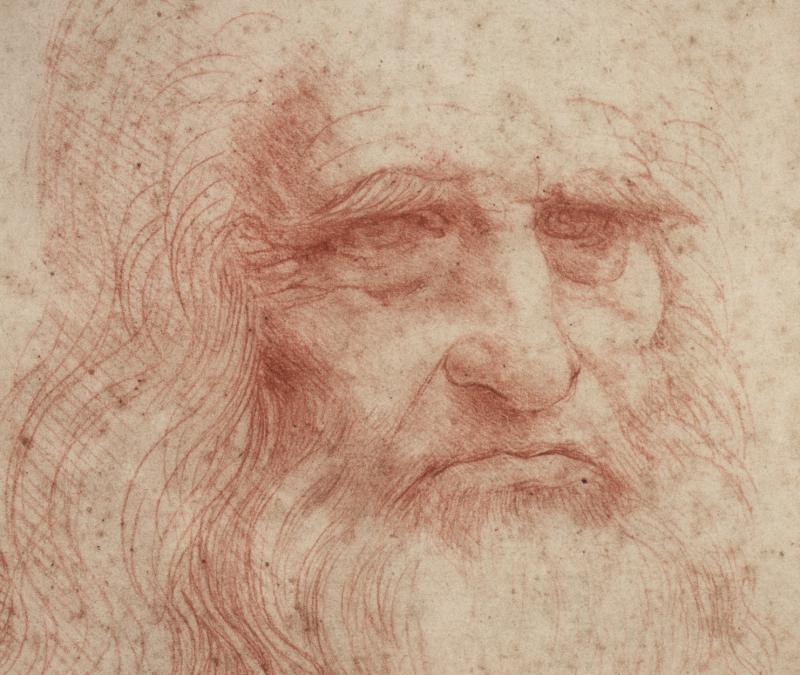Say ’Leonardo’ and Da Vinci slips off the tongue. In every part of the civilised world this artist is recognised for his extraordinary talent and insight.
Leonardo the child and youth
Born in 1452, Leonardo became famous in his own lifetime.
It is said he was the love child of a man who belonged to a noble Florentine house of Vinci, in the Val d'Arno. Young Leonardo was apparently a beautiful child and later his good looks, combined with his confidence and talents, added grace to his presence in the courts and social circles of the time. Men were said to be in awe of his beauty.
While very young he was already designing and constructing objects. His father took him to Florence to a famous artist Andrea del Verrocchio, who practised his art in various media. Here Leonardo was surrounded by intriguing artefacts and paintings. Verrocchio was skilled in all manner of crafts.

Leonardo’s curiosity
In this time he was drawn to the intelligence of nature and immersed himself in studying nature’s secrets. He was fascinated and explored design, colour and the order and patterns within nature, including the movements of the heavenly bodies across the sky.
He observed and took notes of his observations. He experimented and documented his experiments. Thirteen volumes of manuscripts are a testament to this.
The work ‘The adoration of Kings’ was created here while he was with Verrocchio, and though unfinished, it remains a masterpiece. (Uffizi Gallery, Florence).
Leonardo had an extraordinary talent, to show deeper than the image or the emotion portrayed in the image. It was as if he wished to show the soul behind the subject to the onlooker.
Leonardo the musician
In 1482 he went to Milan. He had recommended himself to Ludvico Sforza, then Duke of Milan, as knowing some military secrets which he could offer. However, when he came it was with a strange harp of his own making with which he charmed Sforza.
Leonardo the painter
During his time under the patronage of Sforza he produced many works, ‘The Last Supper’ (Monastery of Santa Maria delle Grazie, Milan) and the famous La Gioconda or Mona Lisa (Louvre, Paris) with the mysterious smile were amongst these.
The early version of the ‘Virgin on the Rocks’ was created about this time (Louvre, Paris).

Leonardo the Inventor and Scientist
His ever curious mind travelled into areas where he explored the mechanisms of movement, geometry, light and water. He was a scientist, inventor and a constant observer of nature. Today, almost five hundred years later, we are still gazing with awe and wonder at his work, his ability to reach the soul through his understanding of life through nature’s orderly patterns.
The crossbow, underwater breathing apparatus, a design for a parachute, an ornithopter are just a few examples of his ideas that have had effect long after his departure.
The Wandering years
Leonardo spent the next few years wandering, and it is not always clear where he was to be found. He did some work for the adventurer Cesare Borgia. This role was in the realm of military engineering. He was then commissioned by the Florentine Republic to work with Michelangelo on the ‘Battle of Anghiari’, a work that was never fully completed by either of these men.
Leonardo was moving around, to Rome then Milan and again back to Florence for the commissioned second version of the ‘Virgin of the rocks’ (National Gallery, London).
The two versions have been brought together for the first time for the exhibition at London’s National Gallery on Leonardo da Vinci : Painter at the court of Milan.

He continued with his experiments and observations, drawings and designs.
Political changes were taking place in Rome at the time, and being suspected of being sympathetic to the French, he decided to accept the offer of Francis I to live in the Chateau d'Amboise, in France.
Francis I already had possession of La Gioconda and was an admirer of Leonardo’s work. It was here that Leonardo da Vinci died in 1519.
This man left us a gift, he went deep, and brought to the surface the world which he discovered beneath that surface. One man’s study of the natural world, both visible and invisible is still discussed and debated, the truths and ideas therein discovered and rediscovered.
His wonderful designs and inventions have been incorporated into mechanisms and machines which were used in his day and have influenced our present time. War machines, flying wings, a swing bridge, an aerial screw, the odometer and many hydraulic machines. Truly Leonardo is one of Italy’s great treasures.
****
Related Articles:
- Saint Anne, Leonardo da Vinci’s Ultimate Masterpiece at the Louvre
- Possible Discovery of Masterpiece by Leonardo
- Mona Lisa's Twin unveiled at the Prado Museum




